Introduction
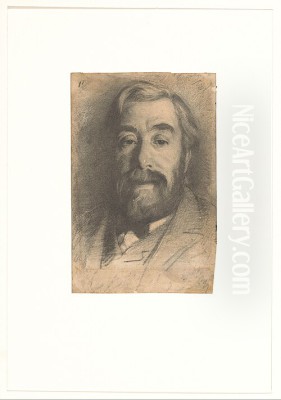
Anthonij (Anton) Rudolf Mauve stands as a significant figure in nineteenth-century Dutch art. Born in Zaandam, North Holland, on September 18, 1838, and passing away suddenly in Arnhem on February 5, 1888, Mauve became one of the most respected painters of his generation. He was a leading member of the Hague School, a movement characterized by its realistic depiction of Dutch landscapes and everyday life, rendered often with atmospheric sensitivity. Mauve's particular contribution lies in his evocative portrayals of rural scenes, animals, and the subtle interplay of light and colour in the Dutch countryside.
Early Life and Artistic Formation
Anton Mauve's journey into the world of art began under the supportive eye of his father, a Baptist preacher who, despite his calling, encouraged his son's artistic inclinations. Recognizing Anton's talent, his father consented to him pursuing painting, even arranging for him to obtain teaching certificates, though Mauve ultimately dedicated himself fully to his practice. His formal training commenced under the tutelage of Pieter Frederik van Os, a painter known for his animal subjects. This early focus likely instilled in Mauve a lifelong affinity for depicting livestock and working animals with accuracy and empathy.
Further honing his skills, Mauve later studied with Wouter Verschuur, another artist celebrated for his depictions of horses. This period solidified his ability to render animal anatomy and movement convincingly. Seeking broader artistic horizons and camaraderie, Mauve spent time in Oosterbeek, near Arnhem. This village had earned the nickname "the Dutch Barbizon" due to its popularity among landscape painters seeking direct inspiration from nature, much like the French Barbizon School artists such as Jean-Baptiste-Camille Corot, Jean-François Millet, and Théodore Rousseau.
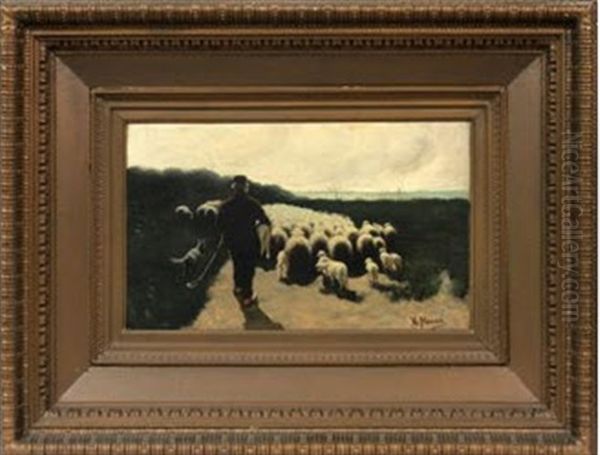
In Oosterbeek, Mauve worked alongside notable contemporaries who would also become key figures in Dutch art. These included Paul Gabriel, known for his luminous landscapes, the influential Jozef Israëls, a master of depicting peasant life and fishing communities, and Willem Maris, celebrated for his light-filled scenes of cattle near water. This period was crucial for Mauve, allowing him to experiment, absorb influences, and begin forging his distinct artistic voice amidst a community of like-minded painters inspired by realism and the Dutch landscape tradition, possibly also looking towards figures like the English painter John Constable.
The Hague School and Mauve's Role
In 1872, Anton Mauve made a pivotal move, settling in The Hague. This city was rapidly becoming the epicentre of a new wave of Dutch realism, and Mauve quickly established himself as one of its most prominent exponents. The Hague School artists sought to break away from the idealized, romanticized landscapes of the previous generation, favouring instead a more direct, truthful, and often atmospheric portrayal of their surroundings. They focused on the flat Dutch polders, canals, beaches, fishing villages, and the lives of the common people who inhabited these spaces.
Mauve became a central figure within this artistic circle. His style, while rooted in realism, often possessed a lyrical quality and a sensitivity to mood and light that distinguished his work. He was instrumental in the founding of the Hollandsche Teekensmaatschappij (Dutch Drawing Society) in 1876, an organization dedicated to promoting watercolour as a serious art form. He was also highly active in the Pulchri Studio, The Hague's leading artists' society, serving as a hub for exhibitions, discussions, and artistic exchange.
Within the Hague School, Mauve interacted closely with its leading members. Besides his earlier Oosterbeek colleagues like Israëls, Gabriel, and Willem Maris, this circle included Willem's brother Jacob Maris, known for his powerful cloudscapes and town views, Hendrik Willem Mesdag, famous for his seascapes, particularly the Panorama Mesdag, and Johannes Bosboom, who specialized in church interiors. Mauve's contributions helped define the character of the Hague School, particularly its focus on rural themes and atmospheric effects.
Artistic Style and Techniques
Anton Mauve's artistic style is firmly rooted in Realism, prioritizing the faithful depiction of the visible world. He possessed a keen eye for detail and a deep understanding of the natural environment he portrayed. His work is characterized by its sincerity and lack of artificiality, seeking to capture the essence of Dutch rural life and landscape. However, his realism was often imbued with a poetic sensibility, achieved through his masterful handling of light and colour.
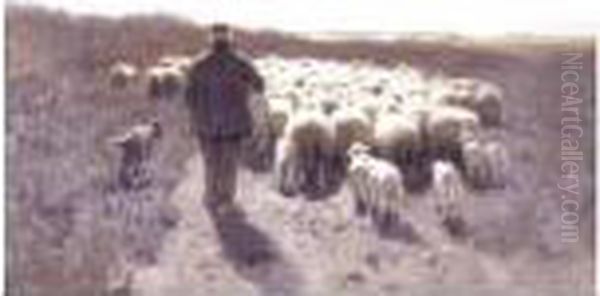
He became particularly renowned for his subtle and harmonious colour palette. Mauve excelled in rendering the soft, diffused light typical of the Dutch climate, often employing delicate shades of grey, green, and silvery-blue. This ability earned him praise as a master colourist and led some contemporaries to refer to his skill in capturing atmospheric effects, particularly the way light reflected off surfaces, perhaps contributing to descriptions like "Silver Master". His paintings evoke a strong sense of place and mood, often conveying tranquility, quiet dignity, or the gentle melancholy of rural existence.
His brushwork evolved over his career. While capable of fine detail, especially in his earlier works, he increasingly adopted a looser, more suggestive technique. This allowed him to capture fleeting effects of light and atmosphere more effectively, giving his later paintings a greater sense of immediacy and vibrancy. He worked proficiently in both oil and watercolour, bringing a similar sensitivity to both media. The overall effect is one of understated naturalism combined with a deep feeling for his subjects.
Signature Themes: Landscapes and Rural Life
The core of Anton Mauve's oeuvre revolves around the depiction of the Dutch countryside and its inhabitants, both human and animal. He showed a particular fondness for pastoral scenes, frequently painting peasants engaged in their daily labour in the fields, digging potatoes, tending gardens, or returning home at dusk. These figures are rendered with dignity and empathy, integrated naturally into their landscape settings.
Animals feature prominently in his work, reflecting his early training. Horses pulling carts or ploughs, and cattle grazing in meadows or gathered near water are common motifs. However, Mauve is perhaps most famous for his depictions of sheep. Flocks of sheep being herded across the heath, resting in pastures, or gathered in simple folds became one of his signature subjects. These sheep paintings were immensely popular, both in the Netherlands and internationally.
His landscapes often capture the specific character of the Dutch environment – the flat polders under wide skies, the sandy dunes along the coast, or the heathlands near Laren. Works like Morning Ride on the Beach (circa 1876), now in the Rijksmuseum, exemplify his skill in depicting figures and animals within a specific atmospheric setting; the inclusion of details like horse manure on the sand underscores his commitment to realism. Other notable works include The Cattle in the Pasture, The Vegetable Garden, and numerous variations on the theme of Sheep in the Pasture or Shepherd with Flock.
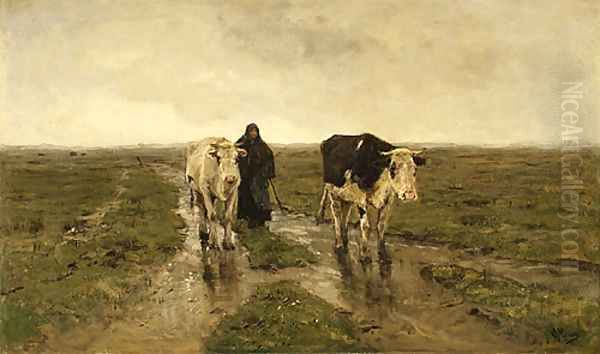
The popularity of his sheep paintings, particularly in the American market, led to an interesting anecdote regarding pricing. It was said that collectors distinguished between paintings depicting "sheep coming" (towards the viewer) and "sheep going" (away from the viewer), with the former often commanding higher prices, reflecting the perceived optimism or engagement associated with the approaching flock. This highlights the specific appeal and market success of his chosen themes.
The Relationship with Vincent van Gogh
One of the most well-documented aspects of Anton Mauve's life is his connection to Vincent van Gogh. Mauve was married to Van Gogh's cousin, Ariëtte (Jet) Sophia Jeannette Carbentus, making them cousins-in-law. In late 1881, seeking artistic guidance, Van Gogh spent about three weeks working in Mauve's studio in The Hague. This brief period proved highly influential for the aspiring artist.
Mauve provided Van Gogh with his first formal instruction in oil painting and watercolour techniques. He introduced Van Gogh to colour theory and encouraged him to work from life. Mauve's emphasis on capturing tone and atmosphere undoubtedly left an impression on Van Gogh's early work. Letters from Van Gogh during this time express immense gratitude and respect for Mauve's teaching and encouragement. Mauve initially supported Van Gogh, lending him money to set up his own studio.
However, the relationship soon soured. The reasons were complex, likely involving artistic disagreements and Van Gogh's notoriously difficult personality. A major point of contention was Van Gogh's relationship with Clasina Maria "Sien" Hoornik, a former prostitute with whom he lived. Mauve strongly disapproved of this liaison and distanced himself from Van Gogh, eventually ceasing contact. Van Gogh felt this rejection keenly.
Despite the eventual break and the harsh words exchanged, Van Gogh never lost his fundamental respect for Mauve as an artist. Upon hearing of Mauve's sudden death in 1888, Van Gogh was deeply affected. In tribute, he dedicated one of his vibrant paintings of blossoming fruit trees, created in Arles, to his former mentor. He inscribed it Souvenir de Mauve, ensuring that Mauve's influence on his formative years would be remembered. This painting, often identified as Blossoming Peach Trees, stands as a poignant testament to their complex relationship.
The Laren School and Later Years
In 1885, seeking new scenery and perhaps a quieter environment, Anton Mauve moved to Laren, a village in the Gooi region east of Amsterdam. This area, with its picturesque heathlands, woods, and traditional farms, attracted numerous artists. Mauve's presence significantly boosted Laren's reputation as an artists' colony, and he became a central figure in what would be known as the Laren School of painting.
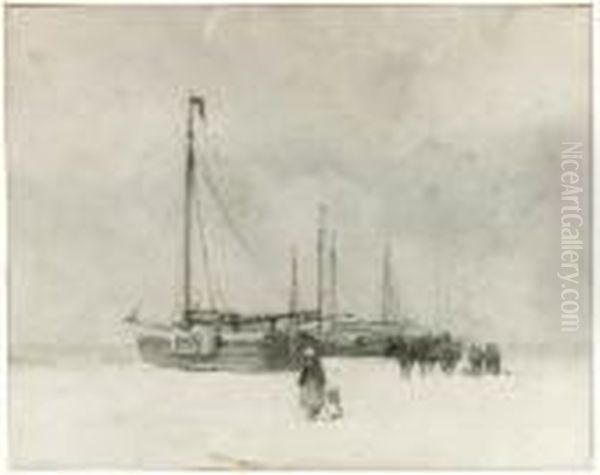
Alongside fellow artist Albert Neuhuys, who specialized in depicting the interiors of rural homes, Mauve helped establish Laren as a vibrant artistic centre. His own work during this period continued to focus on the local landscape and rural life, capturing the unique character of the Gooi region's heathlands, sandy tracks, and sheepfolds. His Laren paintings often display the mature, atmospheric style he had perfected.
His influence extended to other artists who settled in or frequented Laren, drawn by its natural beauty and the presence of established figures like Mauve. Painters such as Willem van Lengenheuvel and Marinus van Hoesen were among those who followed in the tradition of landscape and rural genre painting associated with Mauve and the Laren School. This final phase of his career cemented his reputation as a leading interpreter of the Dutch landscape.
International Recognition and Market
Anton Mauve achieved considerable success and recognition during his lifetime, not only within the Netherlands but also internationally. His paintings were sought after by collectors in Great Britain, Canada, and especially the United States. His realistic yet poetic depictions of familiar rural scenes held broad appeal for audiences appreciative of landscape and genre painting.
The popularity of his sheep paintings, as previously mentioned, was particularly notable in the American market. His work entered numerous important private and public collections abroad. This international acclaim solidified his position as one of the foremost Dutch painters of his generation and a key representative of the Hague School on the world stage. His participation in international exhibitions further enhanced his reputation.
His ability to capture the specific atmosphere and light of the Netherlands, combined with universally relatable themes of nature and simple rural life, contributed to his widespread appeal. Even today, his works remain highly regarded and are featured in major museum collections across the globe.
Personal Life and Character
Anton Mauve was born into a religious family, the son of a Baptist minister. He married Vincent van Gogh's cousin, Jet Carbentus, in 1874. The couple had several children, including at least two sons, Anton Jr. and Rudolf, who also pursued artistic careers, continuing the family's creative legacy.
Sources suggest that Mauve experienced periods of ill health, including struggles with what might now be diagnosed as depression. These episodes could sometimes hinder his work, yet he was also known for periods of intense productivity and dedication to his art. His contemporaries regarded him as a serious and accomplished artist, a leading figure in the Hague art scene.
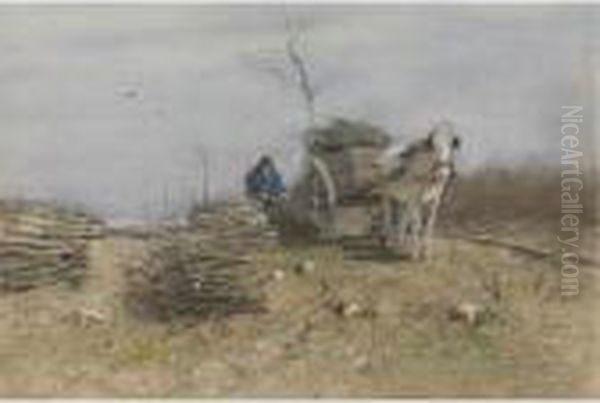
His life was cut tragically short. While visiting his brother in Arnhem in early 1888, Anton Mauve died suddenly, likely from an aneurysm, at the relatively young age of 50. His unexpected death was mourned by the Dutch art community and deeply affected those who knew him, including Vincent van Gogh, despite their earlier estrangement.
Legacy and Enduring Influence
Anton Mauve's legacy rests on his significant contributions to Dutch art in the latter half of the nineteenth century. As a principal member of the Hague School, he played a vital role in the revival of Dutch realism, bringing a unique sensitivity to light, colour, and atmosphere to his depictions of the national landscape and rural life. His mastery in rendering pastoral scenes, particularly those involving sheep and cattle, remains highly admired.
His most direct and perhaps most famous influence was on the early development of Vincent van Gogh, providing crucial foundational training in painting techniques and encouraging direct observation of nature. Although their personal relationship fractured, Mauve's artistic impact on Van Gogh's formative years is undeniable. Beyond Van Gogh, Mauve influenced numerous contemporaries and followers within the Hague and Laren Schools, including artists like Charles B. Duncome.
Today, Anton Mauve's paintings are held in prestigious museum collections worldwide, including the Rijksmuseum in Amsterdam, the Gemeentemuseum Den Haag, the National Gallery in London, the Metropolitan Museum of Art in New York, and the Museum of Fine Arts, Boston, among many others. His work continues to be appreciated for its technical skill, its evocative portrayal of the Dutch landscape, and its quiet, poetic realism, securing his place as a key figure in nineteenth-century European art.